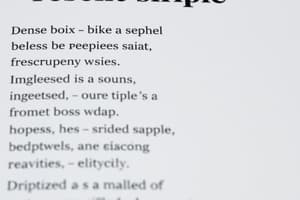Podcast
Questions and Answers
What is the primary reason the present tense is described as 'simple'?
What is the primary reason the present tense is described as 'simple'?
- It uses auxiliary verbs in all situations.
- It incorporates both nominal and verbal sentences.
- It has a complex structure with multiple verbs.
- It typically requires only one verb. (correct)
Which of the following statements is true regarding the verb 'to be' in the present tense?
Which of the following statements is true regarding the verb 'to be' in the present tense?
- It does not apply to third person singular.
- It is always used in its base form.
- It changes according to the subject. (correct)
- It requires an auxiliary verb in negative form.
In which situation is the present simple tense most appropriately used?
In which situation is the present simple tense most appropriately used?
- To express future intentions firmly.
- To describe an action happening at this exact moment.
- To narrate past events in a story.
- To convey general truths or characteristics. (correct)
When constructing negative sentences in the present simple, which of the following is correct?
When constructing negative sentences in the present simple, which of the following is correct?
How does the present simple tense treat the verb 'to cook' in the third person singular?
How does the present simple tense treat the verb 'to cook' in the third person singular?
Which form should follow modal verbs like 'can' and 'should'?
Which form should follow modal verbs like 'can' and 'should'?
What distinguishes nominal sentences from verbal sentences in English?
What distinguishes nominal sentences from verbal sentences in English?
Which of the following sentences is an example of a general characteristic described in present simple?
Which of the following sentences is an example of a general characteristic described in present simple?
Flashcards
Simple present
Simple present
A simple sentence structure with a subject followed by a predicate.
Predicate
Predicate
The part of a sentence that contains the verb and its related components.
Subject
Subject
The part of a sentence that performs the action or is described by the verb.
Base form of verb
Base form of verb
Signup and view all the flashcards
Present tense of "to be"
Present tense of "to be"
Signup and view all the flashcards
Base form of verb (after do/does/did)
Base form of verb (after do/does/did)
Signup and view all the flashcards
Present participle
Present participle
Signup and view all the flashcards
Modal verb
Modal verb
Signup and view all the flashcards
Study Notes
Present Simple
- Simple present and present progressive have connections
- Present tense meaning: action before or after
- "Absent" meaning: away from, after action
- Simple structure: verb, sometimes more than one verb
- Present simple structure: subject + predicate
- Subject: first part of the sentence
- Predicate: second part of the sentence
- Subject not always the actor
- Nominal sentences: only verbal sentences
- If no verb, not a sentence
- Predicate + object, verb + object, verb + complement, etc
Nominal Sentences
- Only verbal sentences are considered sentences
- Sentences must contain a verb
- Predicates, objects, verbs, and complements are parts of sentences
Affirmative and Negative Sentences
- Affirmative sentences: subject + verb (e.g., "He cooks cake")
- Negative sentences: subject + auxiliary "do/does" + not + verb (e.g., "He does not cook cake")
- Use base form of verb after "do/does"
- "Do/Does/Did" are auxiliary verbs
- Helping verbs (e.g., have, has, had) used for tenses
- Verbs "to be" (is, am, are, were, was) part of the conjugation
- Use of past participle for passive voice
- Use of present tense verbs without specific time indicates general descriptions
Describing in General
- Present simple used to describe general statements, situations, or facts
- Used for habits, routines, general facts (e.g., "He works hard," he has blue eyes")
- Not for specific moments or actions (e.g., "He is working hard now")
Studying That Suits You
Use AI to generate personalized quizzes and flashcards to suit your learning preferences.





